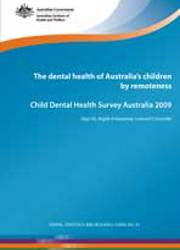Summary
This publication describes the state of dental health of Australian children examined by school dental service staff in 2009 and provides insights into the dental health of rural children. The findings are drawn from the Child Dental Health Survey 2009, in which the data of 87,269 children aged 5-14 from most states and territories, except New South Wales and Victoria, were collected and analysed. Any comparisons with previous years or international statistics should be made with caution due to missing data from New South Wales and Victoria.
Dental decay is relatively common among Australian children
Just over half (51%) of children aged 6 attending a school dental service had a history of decay in their deciduous ('baby') teeth-that is, 1 or more decayed, missing or filled deciduous teeth (dmft). On average, children aged 6 had 2 or more dmft each (mean dmft = 2.36). Among children aged 12, nearly half (45.0%) had experienced decay in their permanent teeth, with 1 or more decayed, missing or filled permanent teeth (DMFT). On average, children aged 12 had just over 1 affected tooth (mean DMFT = 1.05).
A minority of children experience a greater amount of dental decay
The one-tenth of children aged 6 with the most extensive history of deciduous tooth decay had almost 10 deciduous teeth affected-more than 4 times the average for children of that age. The one-tenth of children aged 12 with the most extensive history of permanent tooth decay had 4.83 permanent teeth affected-about 4 times the average for children of that age.
Dental decay varies across the regions
Children who lived in Remote/Very remote areas were at increased risk of dental decay compared with those who lived in Major cities. The mean number of dmft at age 6 and the mean DMFT at age 12 were higher among children in Remote/Very remote areas than among those in Major cities.
Conclusions
Dental decay was relatively common among Australian children who attended a school dental service.
A minority of children still experience a much greater amount of dental decay than average burden of disease.
Children in Regional and Remote areas were at increased risk of dental decay in their deciduous teeth compared with those in Major cities.



